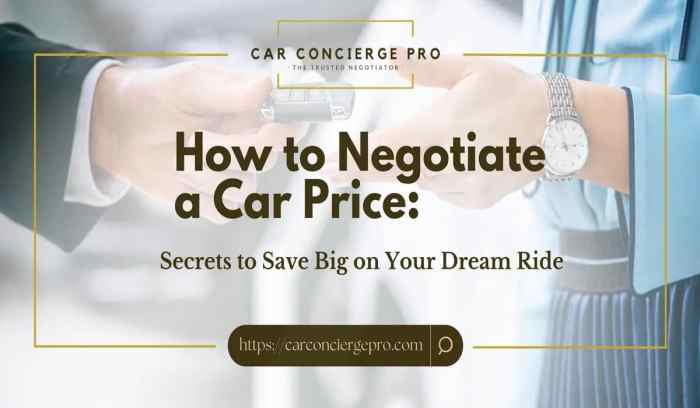Negotiating Sticker Price on New Car
Understanding the Sticker Price
Negotiating sticker price on new car – The sticker price, or Manufacturer’s Suggested Retail Price (MSRP), isn’t the final price you’ll pay for a new car. It’s a starting point, a foundation upon which various fees and charges are added. Understanding these components is crucial for effective negotiation.
Components of the Sticker Price

Source: forbes.com
The sticker price comprises the base vehicle price, representing the cost of the car itself without any additional features or packages. To this, several other charges are added. These include the manufacturer’s suggested retail price (MSRP), which serves as a benchmark, although dealers often negotiate below this figure. Additional fees such as destination charges (covering transportation to the dealership), dealer preparation fees (covering detailing and other pre-delivery tasks), and government fees (taxes, title, registration) inflate the sticker price.
Manufacturer’s Suggested Retail Price (MSRP) and its Influence
The MSRP is the price the manufacturer recommends the dealer sell the vehicle for. While it influences negotiations, it’s not necessarily the price you should expect to pay. Dealers often adjust their prices based on market demand, inventory levels, and their own profit margins. The MSRP primarily serves as a reference point during the negotiation process.
Examples of Additional Fees
Beyond the base price and MSRP, several additional fees are typically included. Destination charges, usually a few hundred dollars, cover the cost of transporting the vehicle from the factory to the dealership. Dealer fees vary widely but cover administrative costs and pre-delivery inspection. Government fees encompass taxes, title fees, and registration fees, which are mandated by state and local regulations.
These fees are usually non-negotiable, but understanding them is key to calculating the total cost.
MSRP vs. Negotiated Price Comparison
| Model | MSRP | Negotiated Price | Difference |
|---|---|---|---|
| Toyota Camry | $26,000 | $24,000 | $2,000 |
| Honda Civic | $23,000 | $21,500 | $1,500 |
| Ford F-150 | $35,000 | $32,000 | $3,000 |
| Chevrolet Equinox | $28,000 | $26,000 | $2,000 |
Researching Market Value
Before stepping into a dealership, thorough research is essential. Knowing the fair market value of the vehicle you’re interested in empowers you to negotiate effectively. Several online resources provide valuable insights.
Resources for Determining Fair Market Value
Kelley Blue Book (KBB) and Edmunds are two leading sources for determining a vehicle’s fair market value. These websites provide detailed pricing information based on various factors such as make, model, year, mileage, condition, and features. Comparing values from multiple sources ensures a more accurate assessment of the car’s worth.
Kelley Blue Book (KBB) and Edmunds Comparison
Both KBB and Edmunds offer similar services, providing estimates for trade-in values and private party sales prices. However, their valuation algorithms may differ slightly, leading to minor discrepancies in the estimated value. It’s advisable to consult both websites to get a comprehensive picture of the market value.
Factors Influencing Market Value
- Mileage: Lower mileage generally translates to higher value.
- Condition: A well-maintained vehicle commands a better price.
- Features: Additional features, such as advanced safety systems or luxury packages, increase value.
- Year and Model: Newer models with popular features are typically worth more.
- Market Demand: High demand for a specific model can drive up its price.
Negotiation Strategies
Negotiating the price of a new car requires a strategic approach. Knowing your walk-away point, understanding common dealer tactics, and presenting a strong opening offer are crucial for securing a favorable deal.
Effective Negotiation Tactics
Start by researching the market value and setting a target price. Present a strong opening offer slightly below your target price, leaving room for negotiation. Be prepared to walk away if the dealer is unwilling to meet your terms. Focus on the total price, including all fees and charges, rather than just the sticker price. Remain calm and polite throughout the negotiation, even if the dealer employs aggressive tactics.
Countering Dealer Negotiation Strategies
Dealers often use high-pressure tactics, such as emphasizing the limited availability of the vehicle or highlighting the benefits of financing through their dealership. Remain firm in your position, counter these tactics with your research and walk-away point. Don’t be afraid to take a break from the negotiation if needed.
Examples of Strong Opening Offers
Based on your market research, a strong opening offer would be a price slightly below the average fair market value for the vehicle. For example, if the average fair market value is $25,000, a strong opening offer might be $23,500. This allows for negotiation while still securing a favorable price.
Step-by-Step Negotiation Guide
- Research the market value.
- Set a target price and a walk-away point.
- Present a strong opening offer.
- Listen to the dealer’s counteroffer.
- Negotiate incrementally, focusing on the total price.
- Handle objections calmly and rationally.
- Be prepared to walk away.
Financing and Incentives
Financing significantly impacts the overall cost of a new car. Understanding financing options and maximizing available incentives are crucial for minimizing the total cost of ownership.
Impact of Financing on Overall Cost

Source: urbanmatter.com
Financing a car involves paying interest on the loan amount. A higher interest rate increases the total cost over the loan term. Conversely, a lower interest rate reduces the overall cost. The length of the loan also affects the total cost; a longer loan term reduces monthly payments but increases the total interest paid.
Financing Options
Two primary financing options are available: loans and leases. Loans involve borrowing the full purchase price and repaying it over a set period with interest. Leases involve paying for the right to use the vehicle for a specific period, typically 2-3 years. At the end of the lease term, you can return the vehicle, purchase it, or lease a new one.
Maximizing Manufacturer Incentives and Rebates
Manufacturers frequently offer incentives, such as rebates, low-interest financing, or special lease deals. These incentives can significantly reduce the overall cost of the vehicle. Research available incentives before beginning negotiations to leverage them effectively.
Comparison of Financing Scenarios
| Financing Option | Interest Rate | Monthly Payment (example) | Total Cost |
|---|---|---|---|
| Dealer Financing | 6% | $450 | $27,000 |
| Bank Loan | 4% | $400 | $24,000 |
| Lease | N/A | $300 | $18,000 (over lease term) |
Dealing with Add-ons
Dealers often try to sell add-ons, such as extended warranties, paint protection, and fabric protection. While some add-ons might be beneficial, many are overpriced and unnecessary. Learning to effectively decline unwanted add-ons is crucial.
Common Dealer Add-ons
Extended warranties offer coverage beyond the manufacturer’s warranty, but they are often expensive and may not be necessary if you plan to sell or trade the vehicle before the manufacturer’s warranty expires. Paint and fabric protection are also frequently offered, but these services are often available at significantly lower prices from independent providers.
Strategies for Refusing Unwanted Add-ons
Politely but firmly decline add-ons you don’t need. Negotiate the price of the vehicle first before discussing add-ons. If the dealer pressures you, reiterate your decision and your reasons for declining. Consider researching alternative providers for add-ons you might want.
Persuasive Arguments for Declining Add-ons
You can politely state that you’ve already factored the cost of potential repairs into your budget or that you’ve researched alternative options for the add-ons at a lower cost. You can also simply state that you are not interested in the add-ons at the offered price.
Add-on Checklist
- Extended Warranty: Is it necessary given your planned ownership duration?
- Paint Protection: Can you find a cheaper alternative?
- Fabric Protection: Do you really need it?
- Other Add-ons: Research their value and compare prices.
The Art of Walking Away
Having a walk-away point is crucial for successful negotiation. Knowing when to walk away demonstrates your resolve and can influence the dealer’s willingness to compromise.
Negotiating the sticker price on a new car can be challenging, requiring research and a firm understanding of market value. This is especially true when considering the potentially higher initial cost of electric vehicles; you can check current prices at this site for a good overview: electric car new price. Knowing the average price helps you effectively negotiate the best deal, whether you’re buying a gas-powered car or an electric one.
Importance of a Walk-Away Point
A walk-away point is the maximum price you’re willing to pay for the vehicle. Setting this limit before beginning negotiations helps prevent emotional decision-making. Sticking to your walk-away point strengthens your negotiating position.
Confidently Walking Away
If the dealer refuses to meet your terms, confidently walk away. This shows you’re serious and not easily swayed. In many cases, the dealer will contact you with a better offer if they believe they’re about to lose the sale.
Psychological Impact of Walking Away
Walking away demonstrates your commitment to your terms and can shift the power dynamic in your favor. The dealer realizes you’re not desperate and may be more willing to negotiate to secure the sale.
Scenarios for Walking Away
Walking away is strategically advantageous when the dealer is unwilling to negotiate reasonably, when the add-on prices are excessively high, or when you feel pressured or uncomfortable during the negotiation process.
Documentation and Finalization: Negotiating Sticker Price On New Car

Source: buildpriceoption.com
Thoroughly reviewing all documents before signing is paramount. Careless oversight can lead to unexpected costs and complications.
Importance of Document Review
Before signing any paperwork, carefully review every detail of the contract. Verify the agreed-upon price, financing terms, add-ons, and all other relevant information. Don’t hesitate to ask questions if anything is unclear.
Common Pitfalls to Avoid
Common pitfalls include overlooking hidden fees, failing to understand financing terms, and neglecting to verify the vehicle’s condition. Ensure all aspects of the agreement align with your understanding.
Pre-Drive-Off Checklist
- Verify the vehicle’s condition matches the description.
- Confirm all agreed-upon terms are accurately reflected in the contract.
- Ensure all necessary paperwork is complete.
Sample Contract Excerpt, Negotiating sticker price on new car
This is a sample excerpt. The actual contract will contain detailed terms and conditions. Ensure you fully understand every aspect before signing. This excerpt is for illustrative purposes only and should not be used as a legal document.
Frequently Asked Questions
What is the best time of year to buy a new car?
The end of the month and the end of the quarter are typically the best times to negotiate, as dealerships often have sales quotas to meet.
How much should I expect to negotiate off the sticker price?
This varies greatly depending on the vehicle and market conditions, but aiming for at least a few hundred to a couple of thousand dollars is a reasonable expectation.
What if the dealer won’t budge on the price?
Be prepared to walk away. A dealer is more likely to negotiate if they think they might lose the sale.
Should I bring a friend or family member to help negotiate?
It can be helpful to have a second person for support, but make sure they understand your budget and goals.





















